
- Home
- India
- World
- Premium
- THE FEDERAL SPECIAL
- Analysis
- States
- Perspective
- Videos
- Sports
- Education
- Entertainment
- Elections
- Features
- Health
- Business
- Series
- In memoriam: Sheikh Mujibur Rahman
- Bishnoi's Men
- NEET TANGLE
- Economy Series
- Earth Day
- Kashmir’s Frozen Turbulence
- India@75
- The legend of Ramjanmabhoomi
- Liberalisation@30
- How to tame a dragon
- Celebrating biodiversity
- Farm Matters
- 50 days of solitude
- Bringing Migrants Home
- Budget 2020
- Jharkhand Votes
- The Federal Investigates
- The Federal Impact
- Vanishing Sand
- Gandhi @ 150
- Andhra Today
- Field report
- Operation Gulmarg
- Pandemic @1 Mn in India
- The Federal Year-End
- The Zero Year
- Science
- Brand studio
- Newsletter
- Elections 2024
- Events
Propelled by increased space traffic, India gets the second spaceport

On February 28, 2024, in the presence of S Somanath, chairman of the Indian Space Research Organisation (ISRO), Prime Minister Narendra Modi laid the foundation stone for the second spaceport at Kulasekharapatnam. A Rohini class RH200-Rohini sounding rocket was launched to mark this occasion. The spaceport will be constructed by a private entity under the supervision of ISRO in the next couple...
On February 28, 2024, in the presence of S Somanath, chairman of the Indian Space Research Organisation (ISRO), Prime Minister Narendra Modi laid the foundation stone for the second spaceport at Kulasekharapatnam. A Rohini class RH200-Rohini sounding rocket was launched to mark this occasion. The spaceport will be constructed by a private entity under the supervision of ISRO in the next couple of years.
The spaceport at Kulasekharapatnam will be the second spaceport, after the first at Satish Dhawan Space Centre (SDSC) at Sriharikota. With the market for small, mini, micro, and nanosatellites skyrocketing, the spaceport was expressly established to launch ISRO’s Small Satellite Launch Vehicle (SSLV) and sounding rockets. As part of the privatisation of the space industry, the second spaceport will essentially be operated and used by private space industries and start-ups under the overall supervision of ISRO.
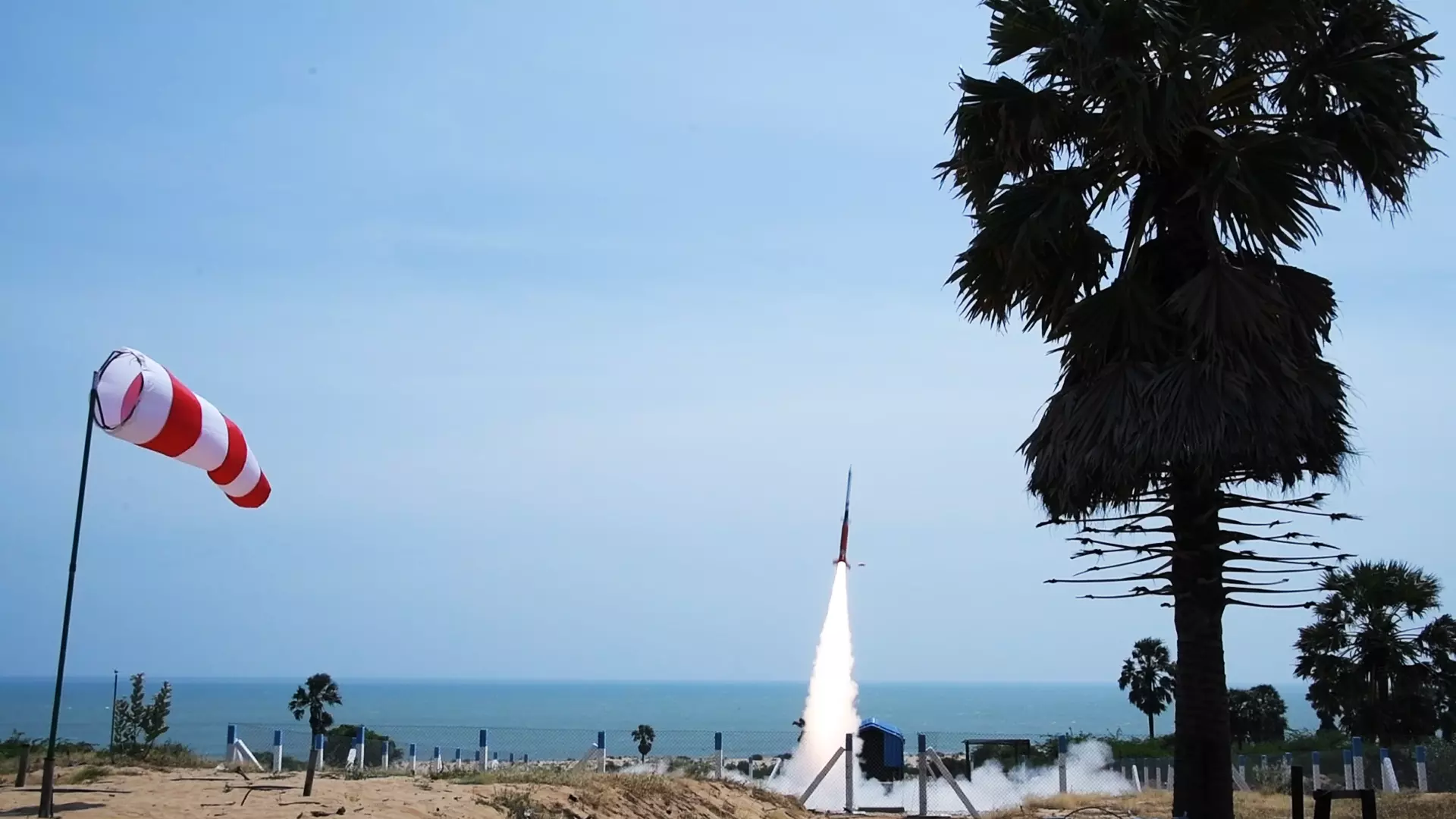
On the day the foundation stone for Kulasekharapatnam spaceport was laid, a Rohini-class-sounding rocket was launched by ISRO.
With increased demand from the private sector for space-based digital communication and internet networks, remote sensing, location and navigation services and geospatial planning, the market for small satellites is exploding. An international survey puts the launch demand at nearly a thousand satellites per year. With the Small Satellite Launch Vehicle-SSLV, ISRO empowers private start-ups to garner a significant share of this emerging space market. The second spaceport at Kulasekharapatnam is specifically built to meet the needs of commercial SSLV launches.
Thumba launch station
The India space sojourn commenced with the establishment of the Thumba Equatorial Rocket Launching Station (TERLS), a launch facility at Thumba, a small fishing hamlet near Thiruvananthapuram, on November 21, 1963. The launchpad was capable of launching sounding rockets that could make sub-orbital flights. The sub-orbital flights are like a stone, propelled vertically up that accent to a maximum height depending upon the initial thrust and falls back. They do not go into an orbit around the Earth.
Initial rockets were gifted or imported, and the Indian scientists and engineers designed and developed our Rohini-class sounding rockets.
Thumba launch facility is now used to launch a 10 kg payload consisting of scientific instruments to study the upper atmosphere and cosmic rays to a height of 80 km using the RH 200 sounding rocket.
With these launch vehicles, the payload, consisting of instruments to study the upper atmosphere and cosmic rays, was hurled to about 80 kilometres. After reaching the maximum height, the payload came down and splashed into the Arabian Sea. The instruments collected precious data during the ascent and descent that helped scientists understand the enigmatic cosmic rays and the mysterious upper atmosphere.
The Thumba launch facility cannot place the payload into orbit, so it is not counted as a ‘spaceport’. Like Thumba, another facility, Balasore Rocket Launching Station (BRLS), has been established at Balasore, Odisha, to test missiles and rockets like Prithvi, Agni, and Dhanush. This, too, is not a spaceport.
Why Thumba?
First, the launch facilities are usually established near the seashore. During the launch, the rocket may explode or need to be aborted. The aborted rocket must not fall on the people, and to prevent hazards to habitation, people from the danger zone around the launch pad are usually evacuated. If the launch facility is near the sea, half of the evacuation zone will fall over the sea, and only less land will need to be acquired.
However, the Thumba Equatorial Rocket Launching Station was explicitly established to launch sounding rockets for research on the upper atmosphere and cosmic rays. Therefore, the choice of the location had to meet the demands of the research objectives, too.
Like the geographical equator splicing the Earth into two hemispheres, a geomagnetic equator splits the geomagnetic field into two. On the landmass of India, the geomagnetic equator passes near the line joining Thiruvananthapuram and Tirunelveli.
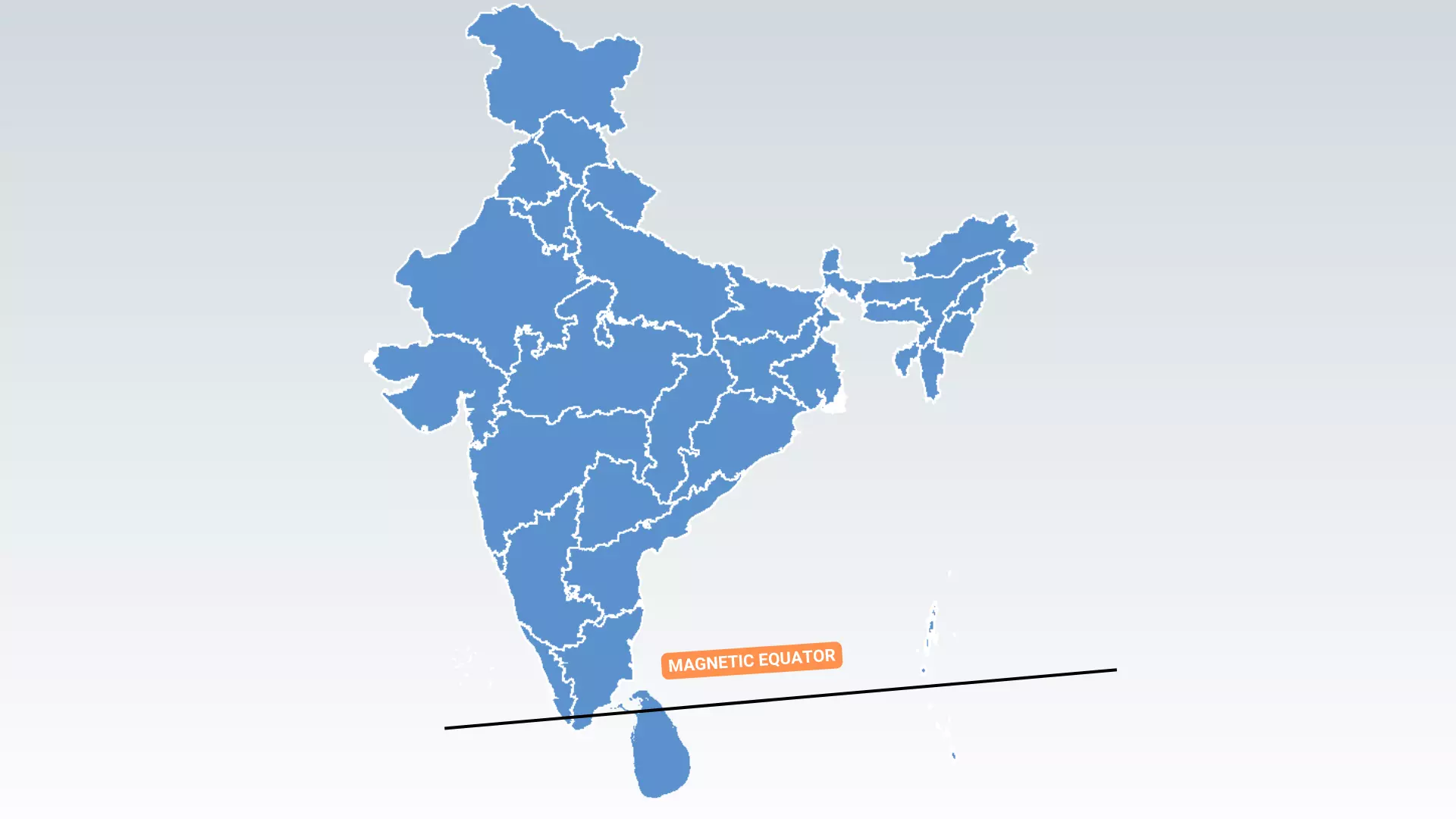
Geomagnetic equator. The geomagnetic equator is nowhere near Chidambaram or Tirunallar. The WhatsApp messages linking the temples located in these towns and geomagnetism are nothing but fake news but fake news.
The geographical equator of the Earth is nearly permanent; however, the geomagnetic equator moves north-south as the magnetic poles shift their position. The launch facility needed to be in this region where the geomagnetic equator swings to study the upper atmosphere and the cosmic rays. Thumba was chosen for the launch facility, and a geomagnetic research station was established at Tirunelveli.
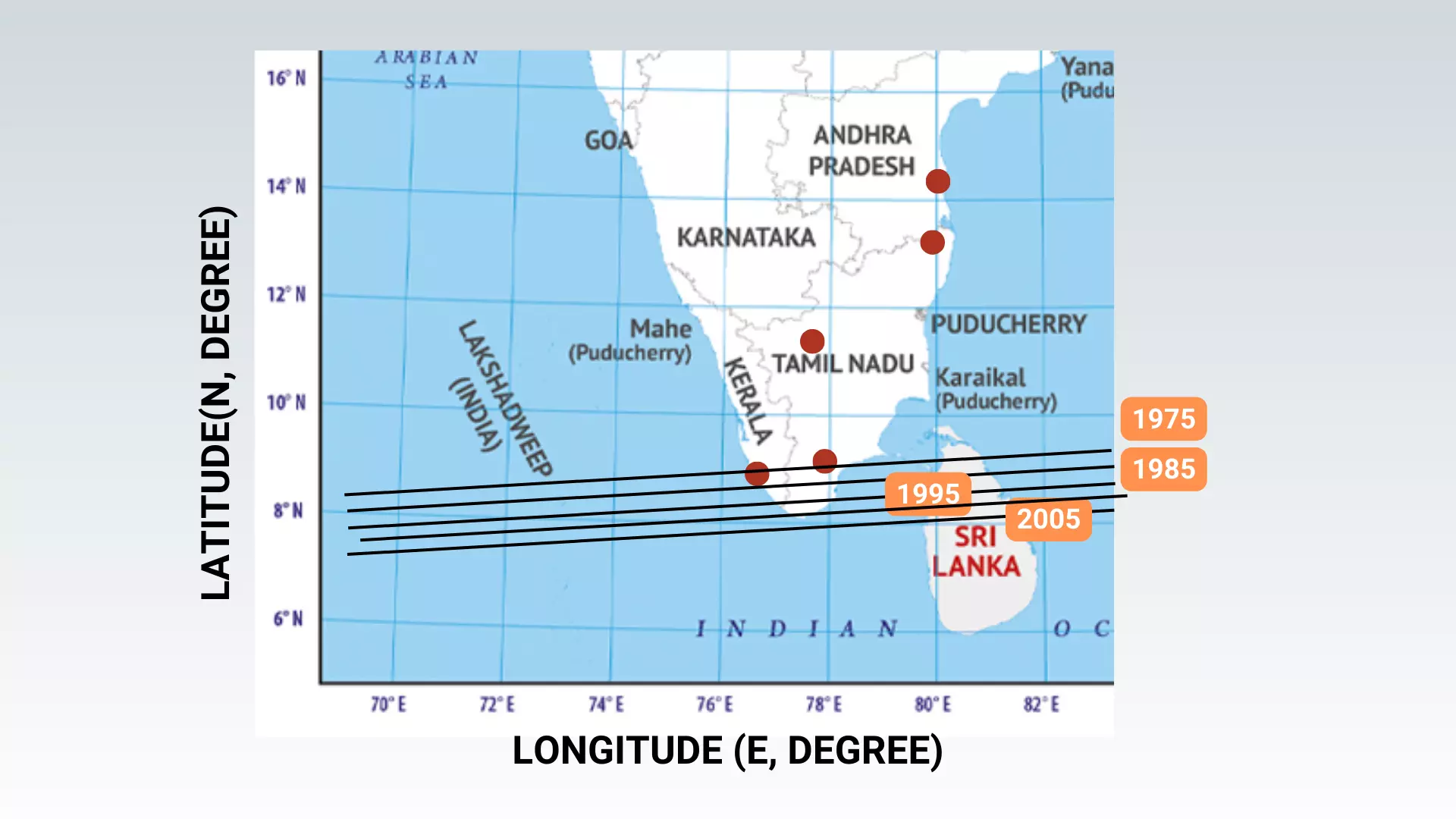
While the geographical equator is permanent, the geomagnetic equator wobbles north-south. The position of the geomagnetic equator from 1975 to 2005 can be seen above.
The first launch from the Thumba facility took place on November 21, 1963. The launches at this facility were the bedrock for the Indian scientists to learn rocket design, construction, development, launch, navigation, control & guidance. Using their experience and learning, they developed step-by-step RH-75, RH-100, RH-125, and RH-200 Rohini class launchers. This led ultimately to the development of the Satellite Launch Vehicle (SLV).
Where to locate a spaceport?
The challenges in placing the payload into orbit are quite different from launching sub-orbital flights.
Imagine I can chuck a ball at 20 km per hour with all my might. Suppose I take a pillion ride on a bike going at 50 km per hour. When I lob the ball with all my might, the ball will be travelling at a speed of 70 (20+ 50) km per hour. The bike's speed is added to the speed of the ball I threw.
Likewise, we can use the rotation of the Earth to add velocity to the rocket.
Earth rotates on its axis from west to east. If we launch the rocket in an easterly direction, then the speed of Earth's rotation will add up to the rocket's speed. The rotational velocity kick from Sriharikota is about 451.9 m/s or 1626.84 km/h; this is a 'free lunch' for a launch from Sriharikota.
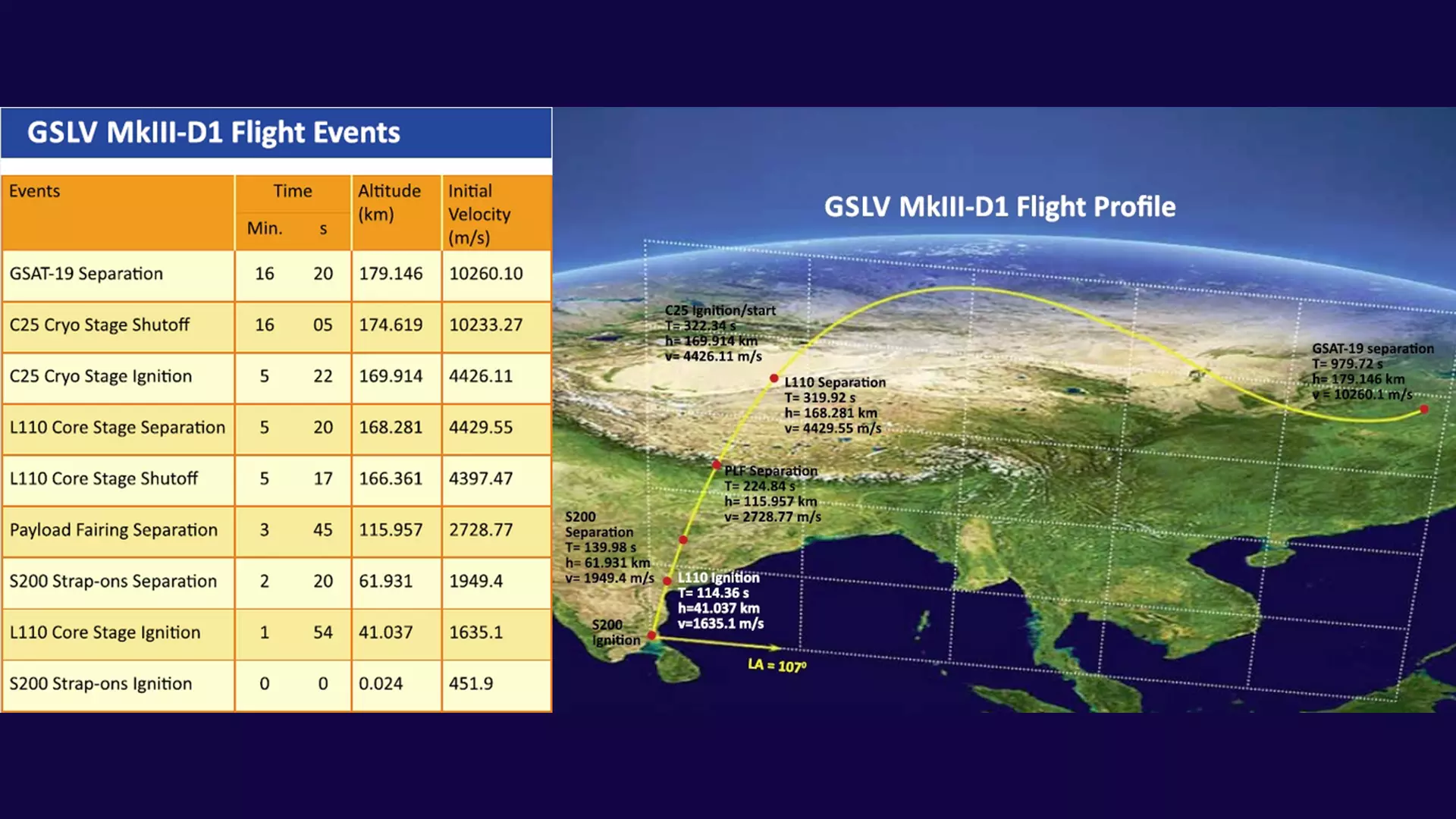
Look at the table above, especially the velocity. At the ground level, even before the ignition, the initial velocity of the rocket is 451.9 meters per second. This is a free allowance provided by the rotation of the Earth at Sriharikota.
The speed of Earth at the equator is around 460 meters per second. However, at 80-degree latitude, the speed is only 81 meters per second. Therefore, one must choose the launch site as close to the equator as possible. This is the first consideration.
That is why the European Space Agency (ESA) has constructed its spaceport thousands of kilometres away at Kourou, a town in French Guyana in South America, located at 5 degrees latitude.
Secondly, the easterly direction must have an expansive sea or uninhabited desert.
Launchers such as Polar Satellite Launch Vehicle (PSLV) and Geosynchronous Satellite Launch Vehicle (GSLV) have multiple disposable stages. After the fuel in a stage is used up, it is jettisoned. This reduces the overall weight of the launcher. Thus, fuel can be used efficiently. We can get more out of every drop of the propellant.
This means while the launcher is in its flight, it will discard debris periodically. The wreak falling from the sky cannot drop on habitations. Therefore, the flight path has to be designed so that the fragments are dumped over the sea or uninhabited desert.
Further, when larger launchers, such as PSLV or GSLV, are launched, a nearly 20 km radius around the launchpad will be a danger zone. However, for SSLV, this evacuation zone is only around one km radius. Dwellings from the launchpad danger zone will have to be evacuated. Thus, it is better to choose a desolate site.
Additionally, one would need good road facilities to transport satellites, fuel and other components. A nearby railway network and airport will help the experts travel.
Considering all these, ISRO chose Sriharikota, a nearly deserted island, for its spaceport in 1969. After the ESA's Kourou, all these make the Sriharikota the second-best spaceport in the world.
Satish Dhawan Space Centre (SDSC) at Sriharikota
The spaceport at Sriharikota was initially called the Sriharikota Range – SHAR. Subsequently, the facility was renamed on September 5, 2002, as a tribute to ISRO's former chairman, Satish Dhawan, and named the Satish Dhawan Space Centre (SDSC)
The maiden flight, an indigenously developed sounding rocket, RH-125 from this centre, was launched on October 9, 1971. After that, the first Indian satellite, Rohini 1A, was launched by SLV-3 on August 10, 1979. The second stage of the SLV-3 failed, leading to aborting of the mission in mid-flight. Eventually, the Rohini-RS-1 satellite was successfully placed in orbit on July 18, 1980, using the SLV3 launcher.
Initially, a SLV3 launchpad was built at this facility. Once ISRO developed more giant launchers, like ASLV, PSLV and so on, a new launchpad was constructed in 1993. This launchpad is used now for PSLV and GSLV missions. A second launchpad was established in 2005 to meet the enhanced launch demand. The human-rated makeover of the second launchpad was completed recently. The second launchpad will be used for ISRO's manned mission in Gaganyaan.
Changing face of the space economy
Low-earth satellites orbiting at an altitude of 400 km will take about 90 minutes to complete one rotation around the Earth. Therefore, the satellite will appear to move in the sky, and the antenna must also synchronously track and turn. Such a communication system is feasible for a research institution or a ground station. However, for a roof-top dish antenna TV, this is impractical. This is why the communication satellites were often stationed in a geosynchronous orbit, about 35,784 km above the equator. In this orbit, the satellites take 23 hours and 56 minutes to make one revolution around the Earth, the same time the Earth takes revolve. Therefore, these satellites appear stationary and stay put at an angle in the sky from a location.
The launch cost to geosynchronous orbit was very high, and to break even, the satellite had to perform for many years. Hence, larger satellites with twenty to thirty-year operational lifespans were preferred in the initial years of the space age. For example, the commercial communication satellite Jupiter 3/EchoStar 24 weighed 9300 kilogrammes. By far, India's heaviest satellite is GSAT-11, weighing 5854 kg with a mission life of 15 years.
On the other hand, electronics are rapidly evolving, and even a two or three-year-old gadget become obsolete. This meant the satellite's electronics quickly became moribund compared to the ground segment.
With the arrival of tower-switching technologies, the situation has drastically changed. Mobile phones seamlessly switch from one tower to another while we travel. Likewise, we can build a communication system with a train of satellites that will appear one after another above the fixed antenna. By switching from one satellite to another, for example, as we do in the case of GPS, coherent, unbroken communication can be established.
The space market is moving towards this space-based switching technology. They are proposing to launch a constellation of satellites that will appear one after another. These do not require the satellites to be taken to the height of 35000 km but are placed in a low earth orbit of 200-300 km altitude. The satellites can now be miniaturised. Therefore, we need only small micro and mini satellites- not heavy elephants.
Further, we can replace the older ones swiftly, as their electronics become obsolete. Consequently, it is adequate to have a lifetime of one to five years. This also implies replacement launches have to be made more often.
Every jack has his jill; likewise, we will require launchers such as PSLV and GSLV to launch massive, heavy payloads. However, the best-suited launcher for small and micro satellites is an SSLV-type launcher.
Sriharikota launch facility
A cat cannot wiggle through a rat hole, but a rat can royally walk through a hole big enough for a cat. A suitable launch facility that can launch PSLV and GLSV is sufficient for SSLV. However, the geographical location of Sriharikota imposes some limitations.
Sriharikota is located at 13-degree latitude. Hence, a craft launched towards the due east will have an orbit inclined to about ~13 degrees. This is good enough for a GeoTrasfer orbit (GTO) to place the craft in a geosynchronous orbit.
However, some satellites have to be placed in polar orbit. Polar orbit is best suited for remote sensing, geospatial mapping, navigation and rescue, weather and earth observation applications. We must launch the craft towards the southern direction for the polar orbit.
Take, for example, the flight path of Cartosat 2F. We can see that the flight initially moves towards the east and makes a sharp turn after crossing Sri Lanka to place the payload in the polar orbit.
There is adequate ocean towards the eastern direction from Sriharikota. However, towards the southern direction, we have the landmass of Sri Lanka. Therefore, the flight path aimed at the polar obit first often travels east and takes a sharp turn after crossing Sri Lanka. The ultimate flight path resembles a dog's leg and is called a 'dog-leg manoeuvrer'.
Due to geographical limitations, the launches from Sriharikota can have, at best, ~19° inclination in the southeast direction. For anything more, one has to resort to a dog manoeuvre.
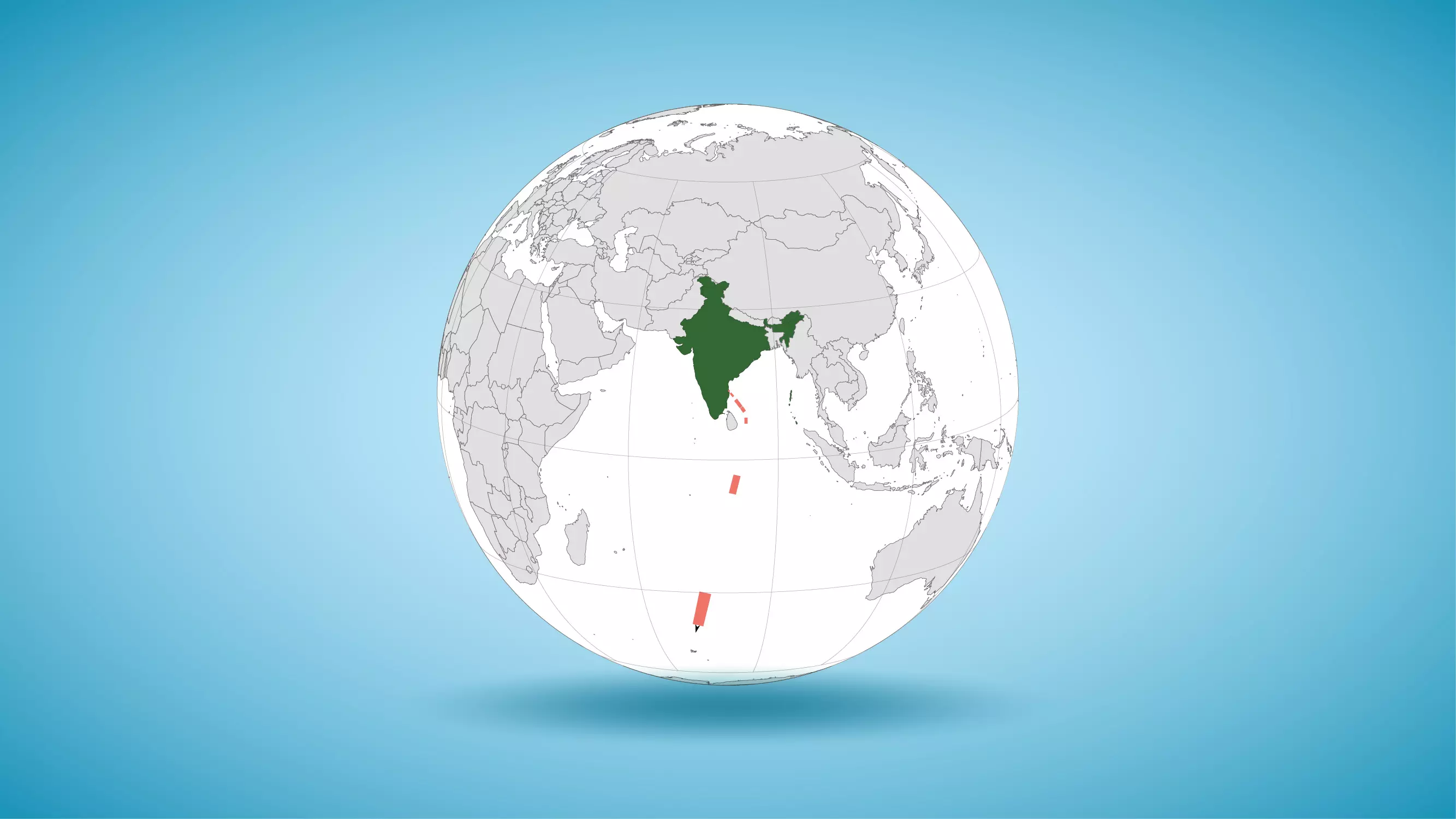
Flight path of Cartosat 2F. Sri Lanka comes in between for a southerly flight path from Sriharikotta. The red-shaded regions are danger zones, where the debris from the multiple stages and boosters will fall into the ocean. The location of these danger zones needs to be over an ocean. This launch mission had seven danger zones, including the launch site. Some initial danger zones would have come above the Sri Lankan landmass if the flight path had been straight. The dog-leg manoeuvrer to avoid the Sri Lankan landmass is clearly seen.
The dog-leg manoeuvrer costs fuel, which is manageable for launchers like PSLV and GSLV. However, SSLV is a small launcher with less fuel. Expending a significant amount to change mid-flight direction is costly, making the mission less economical.
The small satellite market is skewed towards low earth polar orbits. The SSLV launched from Sriharikota, making a dog-leg manoeuvrer, will demand higher fuel, making the launch less economical.
A launch site with an unhindered expanse of sea towards the southern side is best suited for SSLV.
Why Kulasekharapatnam?
Kulasekharapatnam is a coastal town with a sea for a considerable distance on its southeastern and southern sides. Further, it is located much closer to the equator; hence, the launch vehicle will get extra punch from the rotation of the Earth.
Naturally, we wonder why the first spaceport was not located at Kulasekharapatnam and why ISRO chose Sriharikota. There are quite a few speculations in social media, some alleging that politicians from Tamilnadu were short-sighted and did not allow the spaceport to come up at Kulasekharapatnam in the late 1960s.
This is nothing but a canard. We cannot use the spaceport at Kulasekharapatnam to launch PSLV and GSLV to GTO orbit.
To understand the choice of Sriharikota for the first spaceport, we must first understand what are known as launch danger zones.
PSLV and GSLV are multi-staged launchers. They also have boosters. After the launch, the empty tanks are jettisoned mid-flight once the fuel is exhausted. For example, the Cartosat 2F had seven such danger zones, the first being the launch site. These zones are computed before the launch, and NOTAM (Notice to Air Missions of Flight Hazards) is issued. Flights and ships are warned not to enter these regions during the launch window.
The image below is the flight path of GSLV-F14, which placed the INSAT-3DS in the Geosynchronous Transfer Orbit (GTO) on February 8, 2024. Later, the craft was put in a Geosynchronous orbit. The flight path is towards the east, and four danger zones can be seen. All these four zones must be over the sea, and no landmass can come in between.
We need to launch towards the easterly direction to place a satellite in geosynchronous orbit. Such a flight path is not feasible from Kulasekharapatnam, where towards the east is the Sri Lankan landmass.
This is why ISRO chose Sriharikota for its first spaceport. The flight can be planned to dunk stages in the Andaman Sea, just short of Thailand. All the boosters must be designed to have a range within this. The later sustainer stages, like the third stage PS3 of PSLV, can be dunked in the Pacific with no issue. These geographical limitations dictate the flight path design and stages for launches from Sriharikota towards the east.
On the other hand, the demand for small satellites is a new and recent development. We need a suitable spaceport to launch crafts into polar orbit to garner the space market for small satellite launches. This is why Kulasekharapatnam was selected as the second spaceport.
This also implies that the Kulasekharapatnam spaceport will have the capacity only to launch SSLV and sounding rockets, not massive launchers like PSLV or GSLV. All the flights from this second spaceport will be southward.
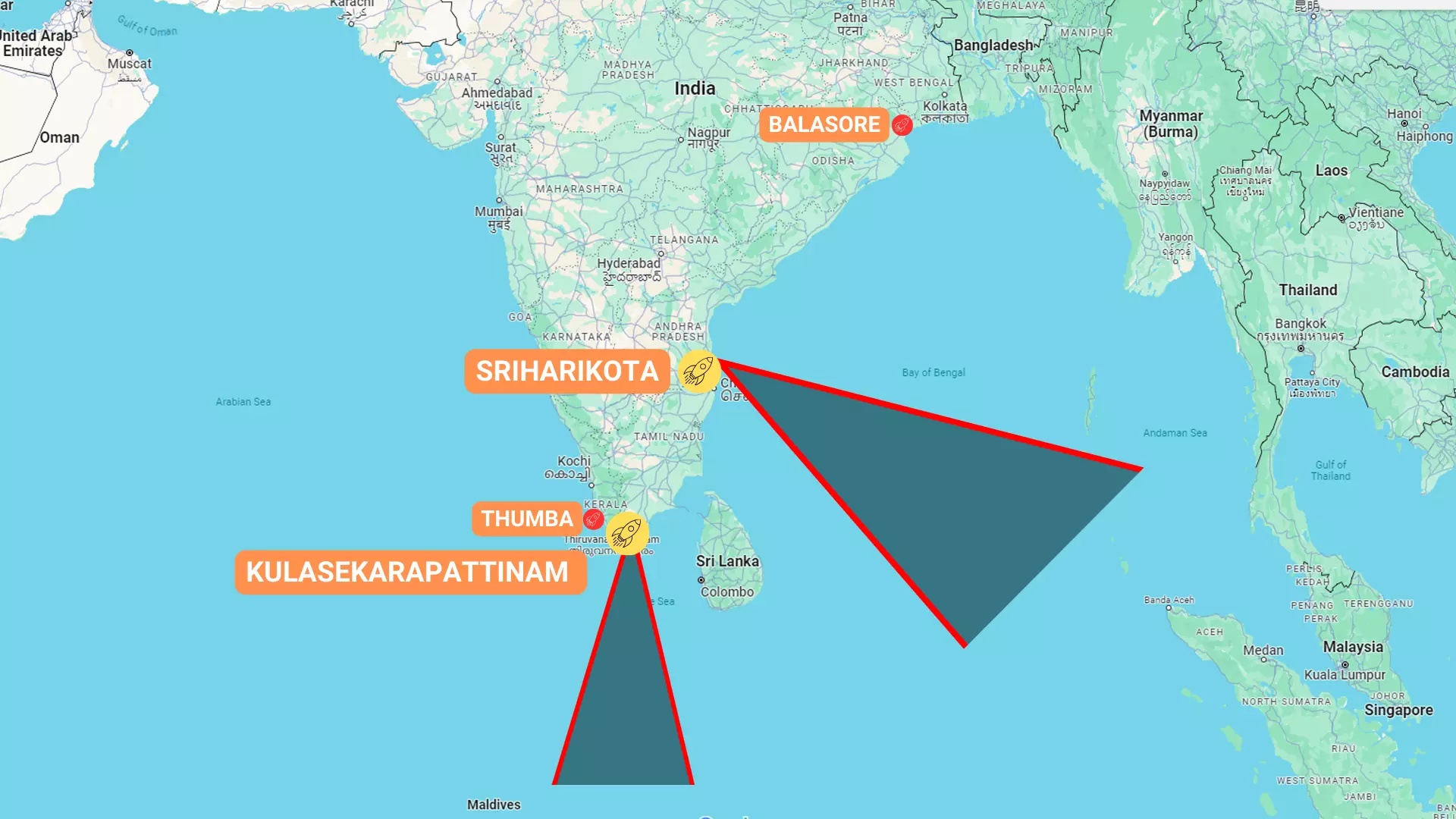
Flight path of GSLV-F14. The first danger zone is the launch site, and the other three are overseas.
Kulasekharapatnam spaceport
Once completed, the spaceport will house various facilities like satellite integration, a fuelling station, a mobile launchpad, and a ground control centre. As only small launch vehicles will be launched from this spaceport, the evacuation zone is only a one-kilometre from the launchpad. Therefore, none of the habitations nearby are in harm's way.
This second spaceport is being developed under the government's space privatisation policy. Hence, the tender for building the complex has been issued. Further, the facilities will be operated by private players under the supervision of ISRO. The ISRO has called for an expression of interest to produce SSLV through technology transfer. The technology of SSLV launch vehicle lock, stock and barrel are to be transferred to the private sector. This is the first time ever, anywhere in the world, a space agency has transferred the complete design of the launch vehicle to the private sector. Nearly 23 private companies are racing for SSLV tech transfer from ISRO.
As an icing on the cake, the Tamil Nadu government has proposed establishing a space tech park in this region. The initial suggestion for establishing a space technology park came from Dr Mayilsamy Annadurai. Several engineering colleges and universities in Tamil Nadu have already built and launched nanosatellites and student satellites. The firecracker & match industry nearby has the know-how of solid propellants. Using human and technical resources, the space tech park could attract start-ups involved in the fabrication of rockets, fuel, electronics, and micro and nanosatellites for commercial applications.
